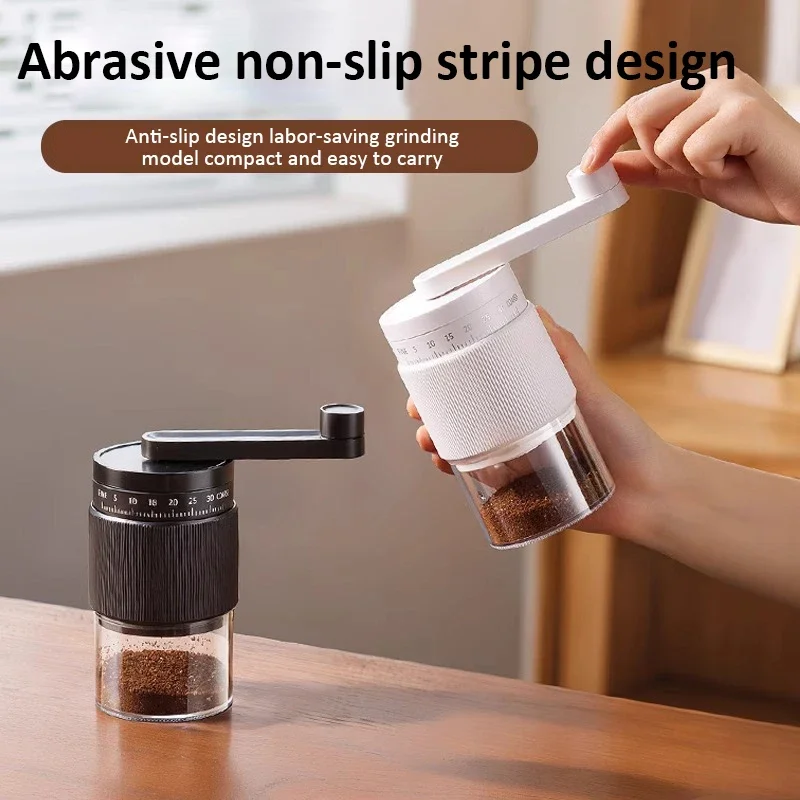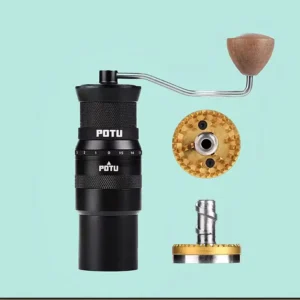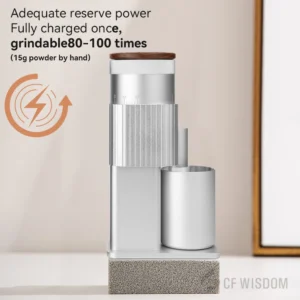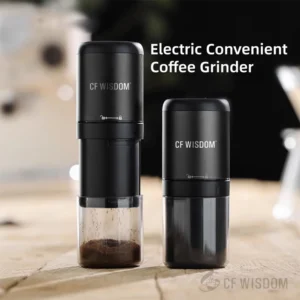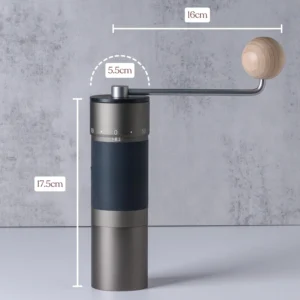Understanding the Espresso Grind Foundation
Making great espresso is like solving a delicious puzzle. At its heart, espresso is unique among coffee brewing methods because it uses high pressure to force hot water through tightly packed coffee grounds in a short time (typically 25-30 seconds), creating a concentrated and complex beverage.
When baristas talk about what makes or breaks an espresso shot, they inevitably focus on one critical factor: grind size. This seemingly small detail actually controls three vital aspects of your coffee:
- Flow rate: How quickly water passes through the coffee bed
- Extraction time: How long the water and coffee interact
- Flavor balance: Whether your espresso tastes sour, balanced, or bitter
The science behind this is fascinating. When you grind coffee beans, you’re increasing their surface area. Finer grounds expose more coffee to water, allowing for faster extraction of flavors, oils, and compounds. Under pressure, this relationship becomes even more important. Too coarse, and water rushes through too quickly (under-extraction). Too fine, and water struggles to pass through (over-extraction).
Here’s what’s crucial to understand: there is no universal “best grind number” that works for everyone. The perfect setting depends on your specific equipment, beans, and even the weather! What works as “setting 15” on one grinder might be completely different on another model.
Instead of chasing a mythical perfect number, mastering espresso precision grind settings involves understanding principles and relationships. As a starting point, espresso grind typically looks finer than table salt but not quite as fine as powdered sugar. In technical terms, ideal espresso grounds usually fall between 200-400 microns in size, though this varies based on many factors.
With quality precision manual grinders designed specifically for espresso, you’ll have the fine adjustment capability needed to dial in the perfect shot. But first, let’s explore why your equipment plays such a critical role in determining your ideal grind.
Your Equipment Determines Your Ideal Grind
The equipment you use creates the framework within which you’ll find your perfect grind setting. Both your grinder and your espresso machine introduce variables that significantly impact what “ideal” means for your setup.
Grinder Variables
Not all coffee grinders are created equal, especially when it comes to espresso:
Burr vs. blade grinders: Blade grinders chop beans randomly, creating inconsistent particle sizes that lead to uneven extraction. Burr grinders crush beans between two surfaces, producing much more uniform grounds. For espresso, burr grinders aren’t just preferred—they’re essential.
Conical vs. flat burrs: Conical burrs tend to produce grounds with a wider particle distribution, often creating brighter, more complex flavors. Flat burrs generally yield more uniform particle size, resulting in cleaner, more consistent shots.
Stepless vs. stepped adjustment: Stepped grinders click between preset positions, limiting your fine-tuning ability. Stepless grinders allow for infinitely small adjustments, which is particularly valuable for espresso where tiny changes make big differences.
Calibration differences: Perhaps most importantly, there’s no industry standard for grind settings. “Setting 5” on one grinder might produce espresso-appropriate grounds, while “Setting 5” on another might be suitable only for drip coffee. This is why the ultimate espresso grind size chart can be helpful when comparing different models.
Espresso Machine Variables
Your espresso machine introduces another layer of variables affecting your ideal grind:
Pump pressure: While 9 bars is the standard pressure for espresso extraction, machines vary in their actual capabilities. Some home machines might run at 15 bars, while others allow pressure profiling.
Basket types: Single, double, or triple baskets all require slightly different grinds. More importantly, precision baskets (with evenly distributed holes) behave differently than standard baskets.
Pressurized vs. non-pressurized baskets: Pressurized baskets create artificial pressure and can work with coarser grinds, making them more forgiving. Non-pressurized baskets require a more precise grind to generate proper resistance.
Preinfusion capabilities: Machines that can pre-wet the coffee grounds at lower pressure before full extraction often allow for slightly coarser grinds.
Flow profiling: Advanced machines that can vary flow rates throughout extraction add another dimension to grind adjustment.
To illustrate how these factors interact, here’s a simplified comparison of grind needs for different common setups:
| Machine/Basket Type | Grind Fineness | Forgiveness | Notes |
|---|---|---|---|
| Entry-level with pressurized basket | Medium-fine | High | Can work with pre-ground coffee |
| Entry-level with non-pressurized basket | Fine | Low | Requires good grinder |
| Prosumer with non-pressurized basket | Very fine | Very low | Demands precise grinding |
| Lever machine | Fine to very fine | Low | Varies with technique |
These equipment variables form the foundation of your espresso journey, but they’re only part of the story. Next, we need to consider how the coffee beans themselves influence your ideal grind setting.
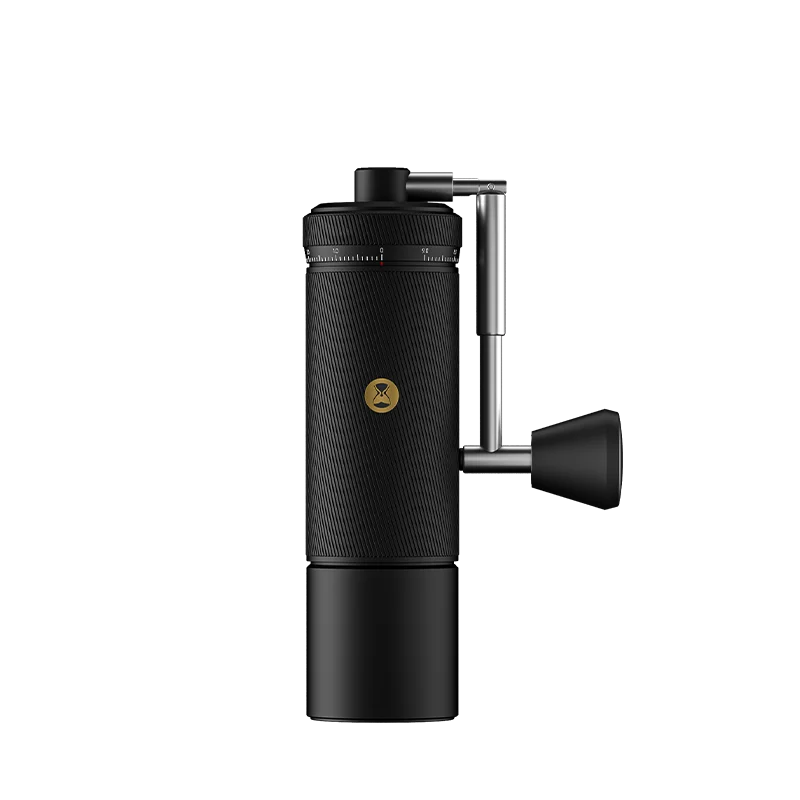
Coffee Bean Variables: How They Affect Your Ideal Grind
Even with identical equipment, your perfect grind setting will change based on the coffee beans you’re using. Understanding these variables helps you anticipate and adjust for them.
Roast Level Impact
The degree to which coffee beans are roasted significantly affects how they grind and extract:
Light roasts are denser and harder, requiring a finer grind to achieve proper extraction rates. Light roasts are less permeable to water, so increasing surface area through finer grinding helps water access the coffee solubles.
Dark roasts have undergone longer roasting, making them more brittle and porous. They also contain more oils on the surface. These characteristics typically mean dark roasts need a slightly coarser grind to avoid over-extraction and bitterness.
Oil content in darker roasts can cause grounds to clump together, potentially leading to channeling (where water finds the path of least resistance through the coffee puck). This may require adjustments to your distribution technique alongside grind size.
Bean Origin and Density
Geographic origin impacts bean density, which in turn affects grinding:
High-altitude beans typically grow more slowly, developing greater density. These denser beans often require a finer grind setting.
Processing methods alter bean structure. For example, naturally processed coffees often need a slightly coarser grind compared to washed coffees from the same region, as their different cell structure affects how water interacts with the grounds.
Age and Freshness
Coffee beans change significantly after roasting, affecting your ideal grind setting:
Fresh beans (1-7 days after roasting) are still actively degassing carbon dioxide, which can cause uneven extraction and require grind adjustments. Many baristas find that beans perform more predictably after 5-7 days of rest.
Peak freshness (generally 7-21 days post-roast) is when beans are most stable for espresso. Your grind setting should remain relatively consistent during this period.
Aging beans (beyond 3-4 weeks) gradually lose gases and become less reactive in the brewing process, often requiring a finer grind to maintain proper extraction rates as they age.
Environmental Factors
Your kitchen environment plays a surprising role in grinding:
Humidity affects how beans grind and extract. Higher humidity can cause grounds to absorb moisture and swell slightly, potentially requiring a coarser grind to maintain flow rate.
Temperature impacts both beans and grinder performance. Cold beans grind differently than room-temperature beans, and grinders that have been running extensively may produce different results due to thermal expansion of their components.
These variables explain why the perfect grind for a freshly roasted Ethiopian light roast might be dramatically different from a three-week-old dark roast Brazilian coffee, even using the same manual coffee grinder for espresso.
With an understanding of how equipment and beans influence grinding, let’s move on to the practical process of finding your ideal setting.
The Dialing-In Process: Your Step-by-Step Guide
“Dialing in” is the systematic process of adjusting variables—primarily grind size—to achieve optimal extraction. Here’s a practical approach to finding your perfect grind setting:
Essential Tools Needed
Before starting, gather these basics:
– Quality burr grinder with fine adjustment capability
– Digital scale that measures to 0.1g precision
– Timer (your phone works fine)
– Naked/bottomless portafilter (helpful but optional)
– Notebook for recording settings
Initial Setup
- Choose your dose based on your basket size (typically 16-20g for a double shot)
- Start with a baseline grind setting:
– If your grinder has an espresso range, begin in the middle
– Visually, aim for a texture similar to fine sugar or salt
– When pressed between fingers, it should clump slightly without feeling powdery - Establish target parameters:
– Brew ratio: Start with 1:2 (e.g., 18g coffee to 36g espresso)
– Shot time: Aim for 25-35 seconds (including pre-infusion if applicable)
The Adjustment Process
Follow this methodical approach to dial in your grind:
Pull your first shot and assess:
– If too fast (under 20 seconds): Grind finer
– If too slow (over 40 seconds): Grind coarser
– If within time range but tastes off: Make smaller adjustments based on tasteMake precise, incremental changes:
– Change only the grind size initially, keeping all other variables constant
– For most grinders, adjust 1-2 settings at a time for major corrections
– For fine-tuning, make the smallest possible adjustmentsPurge between adjustments:
– Discard a small amount of coffee after changing settings
– This clears the previous grind size from the burrsDocument everything:
– Record grind setting, dose, yield, time, and taste notes
– This creates a reference point for future sessions
Visual and Taste Assessment
Learn to recognize the signs of proper extraction:
Visual indicators:
– Flow should begin with dark drops that develop into a steady stream with the consistency of warm honey
– Even extraction across the bottom of a naked portafilter
– Rich, tiger-striped crema
Taste indicators:
– Balanced flavor (not predominantly sour or bitter)
– Appropriate intensity and sweetness
– Pleasant aftertaste without lingering bitterness
The mastering perfect espresso grind adjustment process often takes several attempts, especially with new beans or equipment. Professional baristas might dial in a new coffee with 3-5 test shots before finding the sweet spot.
Using fine adjustment hand grinders gives you the precision needed for this process, with the added benefit of making small, controlled changes that electric grinders sometimes can’t manage. The tactile feedback from manual grinding also helps develop your intuition about bean density and proper grind consistency.
Remember that dialing in is both a science and an art—measurements matter, but ultimately, your taste preferences determine what’s “perfect.”

Grind-Related Problems and Solutions
Even with careful dialing in, you may encounter these common issues. Here’s how to diagnose and solve them:
Channeling Issues
Problem: Water finds paths of least resistance through your coffee puck, leading to uneven extraction.
Visual signs:
– Spurting or spraying from the bottom of the portafilter
– Blonde spots appearing early in extraction
– Holes or craters in the used puck
Solutions:
– Adjust distribution technique (WDT method with a fine needle tool)
– Ensure level tamping with appropriate pressure
– If too fine, coarsen grind slightly to reduce excessive pressure
– Check for appropriate dose for your basket size
Extraction Problems
Under-extraction
– Signs: Sour, sharp taste; watery mouthfeel; shot runs too quickly (under 20 seconds)
– Solution: Grind finer to increase resistance and extraction time
Over-extraction
– Signs: Bitter, astringent taste; hollow mouthfeel; shot runs too slowly (over 35-40 seconds)
– Solution: Grind coarser to decrease resistance and extraction time
Combination Problems
– Signs: Both sour and bitter flavors; uneven streams from naked portafilter
– Likely cause: Channeling (water flows quickly through some areas while over-extracting others)
– Solution: Improve distribution and consider whether grind is too fine causing excessive pressure
Flow Issues
Machine Choking
– Problem: No flow or only slow drips
– Cause: Grind too fine, dose too high, or both
– Solution: Coarsen grind in small increments until flow begins
Gushing
– Problem: Shot pulls too quickly with little resistance
– Cause: Grind too coarse, dose too low, or poor distribution
– Solution: Grind finer and ensure proper dosing
Inconsistent Flow
– Problem: Flow starts/stops or changes dramatically during extraction
– Cause: Often channeling or grind inconsistency
– Solution: Check grinder for consistency issues and improve distribution technique
Pressure Gauge Reading Issues
For machines with pressure gauges:
– Too high pressure (over 10 bar): Grind is likely too fine
– Too low pressure (under 8 bar): Grind is likely too coarse
– Target range: Most machines perform best between 8-10 bar during extraction
For persistent issues that don’t respond to grind adjustments, consider whether your adjusting grind size for espresso shot timing needs to be complemented by changes to other variables like dose or brewing temperature.
Remember that changing grind size affects both flow rate and extraction efficiency. Finer grinds increase extraction but decrease flow; coarser grinds decrease extraction but increase flow. The perfect setting balances these factors for your specific beans and equipment.
Advanced Techniques for Perfect Grind Settings
Once you’ve mastered the basics of dialing in, these advanced techniques can take your espresso to the next level:
Grind Distribution Techniques
The way grounds are distributed in the portafilter is almost as important as the grind size itself:
WDT Method (Weiss Distribution Technique): Using a fine tool (like acupuncture needles in a cork), gently stir the grounds in the portafilter to break up clumps and create even density. This dramatically improves extraction consistency.
Distribution tools: Various leveling tools help create a perfectly flat coffee bed before tamping, ensuring even water contact and pressure.
Clump-breaking strategies: Grinding directly into the portafilter can create clumps. For finest results, grind into a small cup first, break up any clumps, then transfer to the portafilter.
Temperature Manipulation
Temperature significantly affects extraction and can require grind adjustments:
Machine temperature: Higher temperatures extract more quickly and may require slightly coarser grinds. Lower temperatures extract more slowly, potentially needing finer grinds.
Temperature surfing: For machines without PID temperature control, pulling a short “blank shot” before your actual shot can help stabilize temperature.
Portafilter temperature: A cold portafilter can slow extraction (requiring finer grind), while a hot one can speed it up (requiring coarser grind).
Pressure Profiling
Advanced users can manipulate pressure during extraction:
Pre-infusion: Low-pressure wetting of grounds before full extraction can allow for slightly finer grinds without choking.
Flow control devices: Aftermarket modifications or built-in features on high-end machines let you vary pressure during extraction, compensating for grind limitations.
Lever machine techniques: The manual control of lever machines allows for intuitive pressure profiling based on feeling resistance.
Grinder Maintenance for Consistency
Maintaining your grinder ensures repeatable results:
- Regular cleaning: Remove coffee oils and particles at least monthly
- Alignment checks: Ensuring burrs are properly aligned maximizes grind consistency
- Seasoning new burrs: New burrs perform better after grinding several pounds of coffee through them
These precision grind adjustment techniques for espresso enhance extraction quality beyond basic grind size changes. The interaction between grind size, distribution, temperature, and pressure is complex but mastering these variables gives you tremendous control over your espresso’s flavor profile.
Fine Adjustment Hand Grinder, Precision Manual Grinder, Travel Coffee Grinder
Price range: $185.11 through $494.63 Select options This product has multiple variants. The options may be chosen on the product pageHand Burr Grinder, Hand Crank Coffee Grinder, Manual Espresso Grinder, Portable Coffee Grinder
Price range: $262.72 through $300.22 Select options This product has multiple variants. The options may be chosen on the product pageHand Burr Grinder, Manual Coffee Grinder Stainless Steel, Precision Manual Grinder
Price range: $183.64 through $187.52 Select options This product has multiple variants. The options may be chosen on the product pageManual Coffee Grinder Stainless Steel, Manual Espresso Grinder, Travel Coffee Grinder
Price range: $276.22 through $276.39 Select options This product has multiple variants. The options may be chosen on the product pageHand Crank Coffee Grinder, Manual Coffee Grinder for Espresso, Manual Coffee Grinder Stainless Steel
$349.15 Select options This product has multiple variants. The options may be chosen on the product page
When to Re-Dial Your Grind Settings
Even perfect grind settings don’t last forever. Understanding when and how to adjust keeps your espresso consistently excellent:
Timing for Regular Adjustments
Be prepared to re-dial your grind in these situations:
- New bag of coffee: Even the same roast and origin will likely require adjustments
- Age progression of current beans: Coffee typically needs finer grinding as it ages (approximately every 5-7 days)
- Seasonal humidity changes: Higher humidity often requires coarser grinding
- After grinder cleaning or maintenance: Removing buildup changes how your grinder performs
- When taste suddenly changes: If your consistent recipe suddenly tastes different
Minor vs. Major Adjustments
Not all changes require starting from scratch:
- Minor adjustments (slight taste change, small timing shift): Make incremental changes of one small step at a time
- Major adjustments (new coffee, significant timing issues): You may need to start closer to your baseline and work from there
A simple tracking system helps tremendously. A notebook with dates, coffee types, grind settings, and results creates a valuable reference that builds your intuition over time.
Building Intuition
With experience, you’ll develop a feel for your equipment:
- You’ll begin to predict how much adjustment different coffees require
- You’ll recognize the visual and tactile feedback from properly ground coffee
- You’ll learn to hear when your grinder sounds “right” for espresso
This intuition doesn’t replace measurement and systematic adjustment, but it adds another layer to your expertise.
The Role of Grind Consistency in Espresso Excellence
Beyond finding the right grind size, the consistency of that grind dramatically impacts your results:
Why Particle Size Distribution Matters
Espresso extraction is particularly sensitive to grind consistency:
- Inconsistent grinding creates a mix of particle sizes
- Finer particles over-extract and become bitter
- Coarser particles under-extract and contribute sourness
- The result is an espresso that tastes both bitter and sour simultaneously
Think of it this way: even with the mathematically “perfect” average grind size, inconsistent grinding means many particles are actually too fine or too coarse.
Grinder Quality Impact
Your grinder’s quality directly affects consistency:
- Entry-level grinders: Produce wider particle size distribution, making dialing in more challenging
- Mid-range grinders: Offer significant improvement in consistency, enabling better extraction
- Premium grinders: Provide the most uniform particle size, allowing for cleaner, more distinct flavor notes
While even the most basic burr grinder is vastly superior to blade grinders, the importance of burr grinders for espresso becomes more apparent as you develop your palate and skills.
Understanding Bimodal Distribution
All grinders produce some amount of “fines” (very small particles):
- Some fines are inevitable and even beneficial for proper extraction
- Excessive fines lead to over-extraction and channeling
- Better grinders produce more controlled amounts of fines
- This affects how you adjust your overall grind setting
Quality grinders minimize unpredictable fines production, giving you more control over your extraction.
Conclusion: Embracing the Journey to Perfect Espresso
As we’ve explored throughout this guide, there is no single “best grind number” that works universally for espresso. Instead, the perfect grind setting is always contextual—dependent on your specific equipment, beans, environment, and even personal taste preferences.
Rather than chasing an elusive ideal number, embrace the process of discovery. The perfect grind is ultimately the one that produces a shot of espresso that you enjoy. Your journey involves learning how different variables interact, developing systematic approaches to adjustment, and training your palate to recognize what works best.
Consistency in your process matters more than any specific number. By establishing reliable methods for adjustment and keeping records of your results, you’ll develop an intuitive understanding of how your equipment and beans interact.
At Savor Suite, we believe that precision grinding tools form the foundation of exceptional coffee. Quality manual grinders offer the fine adjustment capability needed to navigate the complex world of espresso extraction. They provide direct, tactile feedback that helps develop your intuition while delivering the consistency needed for excellent results.
The pursuit of perfect espresso is both a science and an art—a lifelong journey of refinement and discovery that rewards patience and attention to detail. With each adjustment, tasting, and refinement, you’re not just making better coffee; you’re developing a deeper appreciation for the remarkable complexity of espresso.
FAQ: Quick Answers to Common Espresso Grind Questions
Is there a universal grind setting for espresso machines?
No. Grind settings vary significantly between different grinders. What works as “setting 8” on one grinder might be completely different on another. Instead of focusing on numbers, look for visual and tactile cues—espresso grounds should resemble fine sugar or salt and clump slightly when pressed between fingers.
How often should I adjust my grind setting?
You should adjust your grind when you change coffee beans, when your current beans age (approximately every 5-7 days), after grinder maintenance, during significant humidity changes, or whenever you notice unexpected changes in flow rate or taste.
Can I use pre-ground espresso coffee?
Pre-ground coffee has significant limitations for espresso. It works acceptably only with pressurized portafilters designed to compensate for suboptimal grind. For standard, non-pressurized baskets, fresh grinding is essential because espresso requires precise grind size adjustment for specific beans and equipment. Pre-ground coffee also stales rapidly, further compromising results.
How much does grinder quality affect espresso taste?
Grinder quality has a massive impact on espresso taste—often more than the machine itself. Better grinders provide more uniform particle size, allowing for cleaner extraction and more distinct flavor notes. Entry-level grinders can make acceptable espresso, but their inconsistency limits how good your shots can be, regardless of your technique or beans.
Why does my grind setting drift over time?
Several factors cause grind settings to drift: burr wear (especially in ceramic burrs), temperature changes in the grinder, calibration shifts from vibration, and parts settling with use. Regular cleaning and occasional recalibration help minimize drift. Quality grinders tend to maintain their settings more reliably than budget models.
For more guidance on finding your correct grind setting for espresso, remember that while this process requires some experimentation, the results are well worth the effort.

